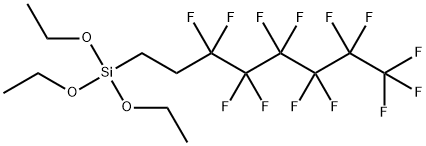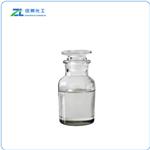Description
1H,1H,2H,2H-Perfluorooctyltriethoxysilane is a fluorinated alkyl silane that is majorly used for improving the wettability of the substrate by lowering the surface energy. It facilitates a superhydrophobic coating by enriching the surface with CF3 group and a water contact angle above 150°. Its wetting property acts in repelling aqueous electrolyte solution away from metallic substrates, thereby giving protection to metal substrate from corrosion. It is used as an active component of fluorine modified ORMOCER (organically modified ceramics) coating materials.
Uses
1H,1H,2H,2H-Perfluorooctyltriethoxysilane (cas# 51851-37-7) is a fluorine based polymer having low surface free energy, enhances its anti-adhesive behavior of polar and non-polar substances. It is used as a coating to improve the insulation of glass wool and mineral wool, and for the anti-icing and anti-corrosion properties of metals.
Application
1H,1H,2H,2H-Perfluorooctyltriethoxysilane is an organosilane compound with a wide range of applications:
POTS can be used as a silane based coating on poly(vinylidene fluoride) (PVDF) to synthesize a membrane for the removal of hazardous volatile organic compounds.
Glass substrates can be modified with POTS to increase the contact angle for 3D reactive inkjet printing of polydimethylsiloxane (PDMS).
It can also be used in the synthesis of superhydrophobic carbon nanotubes(CNT) hollow membranes for membrane desalination (MD) as eco-friendly products of fresh water. It is deposited on the roughened surface of titanium to render it superhydrophobic.
It is utilized in the surface modification of glass nanoparticles.
Used to prepare water-proof, oil-proof and anti-fouling treatment agents, and it can be used in the protection of water-proof, anti-fouling and weathering of cultural relics, masonry, metal, wood, etc.
General Description
1H,1H,2H,2H-Perfluorooctyltriethoxysilane(POTS) is a fluorine based polymer. POTS possesses low surface free energy leading to its anti-adhesive behavior to polar and non-polar substances. It shows very good weathering stability on account of the carbon- fluorine bond. POTS hydrolyzes in wet environment to form silane based film and self healing anticorrosive polymers, the film formed from the hydrolysis and polycondensation of POTS and water is hydrophobic in nature. This wetting property acts in repelling aqueous electrolyte solution away from metallic substrates and hence providing corrosion protection to metal substrate.
Health Hazard
The material can produce chemical burns within the oral cavity and gastrointestinal tract following ingestion. Swallowing of the liquid may cause aspiration into the lungs with the risk of chemical pneumonitis; serious consequences may result. Ingestion of acidic corrosives may produce burns around and in the mouth, throat, and esophagus. The material can produce chemical burns to the eye following direct contact. Vapors or mists may be extremely irritating. If applied to the eyes, this material causes severe eye damage. Direct eye contact with acid corrosives may produce pain, tears, sensitivity to light, and burns. Mild burns of the epithelia generally recover rapidly and completely.
Flammability and Explosibility
Not classified
Advantages
1H,1H,2H,2H-Perfluorooctyltriethoxysilane could enhance the environmental durability of superhydrophobic surfaces, especially under UV irradiation. In per-fluorinated silane, all the hydrocarbon groups in the backbone are saturated by fluorine, which eliminates the possibility of cross-linking under UV irradiation. 1H,1H,2H,2H-Perfluorooctyltriethoxysilane could be applied to the cotton fabric samples using the pad-dry-cure method[1-2].
References
[1] Jelena Vasiljevi?. "Influence of oxygen plasma pre-treatment on the water repellency of cotton fibers coated with perfluoroalkyl-functionalized polysilsesquioxane." Fibers and Polymers 17 5 (2016): 695–704.
[2] Ziqi Sun. "Robust superhydrophobicity of hierarchical ZnO hollow microspheres fabricated by two-step self-assembly." Nano Research 6 10 (2013): 726–735.




